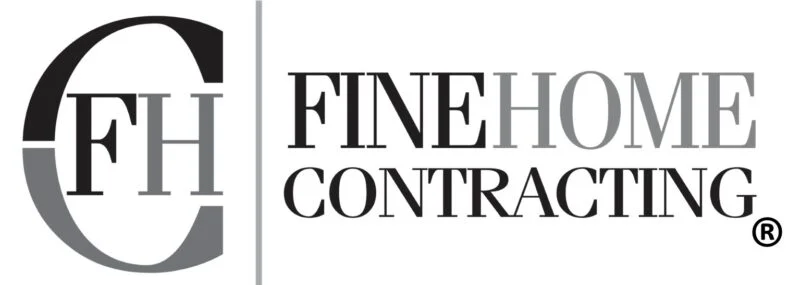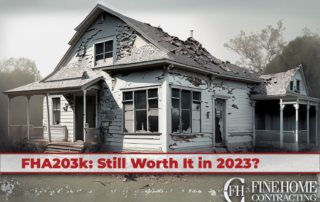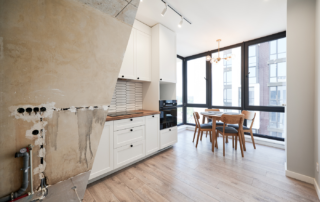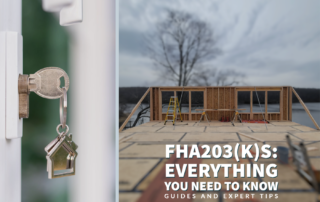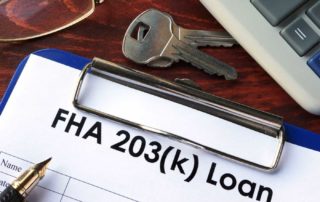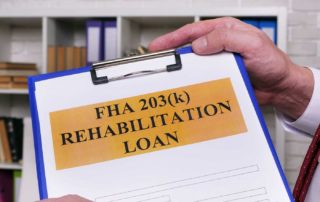Renovating a property can be an exciting and rewarding experience, but it often comes with its fair share of challenges and financial hurdles. This is where FHA203k Renovation Loans come into play. If you’re looking to finance a home renovation project, these loans offer a viable solution that allows you to purchase a property and finance its rehabilitation costs in a single mortgage. In this comprehensive guide, we will walk you through the timelines, steps, and checklists involved in successfully completing a renovation project using FHA203k loans. From understanding the eligibility requirements to managing the renovation process, this article will provide you with the necessary insights and knowledge to navigate through the intricate world of FHA203k renovation loans. Whether you’re a first-time homebuyer or an experienced investor, this guide will equip you with the information you need to make informed decisions and ensure a successful and well-managed renovation loan project.
Introduction to FHA203k Renovation Loans
What is a FHA203k Renovation Loan?
If you’re in the market for a fixer-upper, but lack the cash to fund the renovations, an FHA203k Renovation Loan might just be your saving grace. This specialized type of loan allows you to borrow money for both the purchase price of the home and the cost of repairs or improvements. It’s like a two-for-one deal that can turn a rundown property into your dream home.
Benefits of FHA203k Renovation Loans
The beauty of FHA203k Renovation Loans is that they offer a variety of benefits that make the whole process less of a headache. For starters, FHA203k loans provide financing for both the purchase and renovation, saving you the hassle of securing different loans for each. Additionally, these loans often have lower interest rates compared to traditional renovation loans, making them more affordable over time. Plus, with the potential to increase the value of your home, you might even be able to build some equity along the way. It’s a win-win situation!
Preparing for a FHA203k Renovation Loan
Understanding Eligibility Requirements
Before diving headfirst into the world of FHA203k Renovation Loans, it’s important to familiarize yourself with the eligibility requirements. These loans are available to both individuals and nonprofit organizations who intend to occupy the property. You’ll also need a credit score of at least 580 and a down payment of 3.5% of the total loan amount. So, make sure to check if you meet these criteria before moving forward.
Gathering Required Documentation
Now that you know you’re eligible, it’s time to gather all the necessary paperwork. This includes your personal identification documents, income verification, employment history, and tax returns from the past two years. It may sound like a lot, but having these documents readily available will make the loan application process smoother and faster.
Assessing Your Budget and Financial Situation
Renovations can be pricey, so it’s essential to have a clear understanding of your budget and financial situation. Take a good look at your income, expenses, and any existing debts to determine how much you can comfortably afford to borrow. It’s crucial to be realistic and avoid biting off more than you can chew. After all, you want to enjoy your renovated home, not stress about the monthly payments.
Finding and Securing the Right Property
Identifying Property Needs and Goals
When searching for a property to renovate, it’s important to identify your needs and goals. Consider factors such as location, size, and layout, as well as the extent of renovations required. Do you want to completely gut and redesign the kitchen, or are you mainly focused on updating the bathrooms? Knowing what you want will help streamline your search and ensure you find a property that aligns with your vision.
Working with Real Estate Professionals
Navigating the real estate market can be overwhelming, especially when you’re looking for a property to renovate. That’s where real estate professionals come in handy. Working with a knowledgeable real estate agent and a loan officer who specializes in FHA203k loans can save you time and headaches. They can help you find properties that are eligible for renovation loans, negotiate the purchase price, and guide you through the loan application process.
Conducting Property Inspections
Once you’ve found a potential property, it’s crucial to conduct thorough inspections. Ensure you get a professional home inspector to assess the structural integrity, electrical systems, plumbing, and overall condition of the property. This will help you identify any hidden issues or potential roadblocks that could affect the renovation process or impact your budget.
Steps and Requirements for FHA203k Loan Approval
Initial Loan Application Process
To kick off the loan approval process, you’ll need to complete the initial loan application. This involves providing all the necessary documentation, including your personal information, income verification, and details about the property. Be prepared to answer questions about the scope of renovations and provide estimates for the costs involved. The more accurate and detailed you are, the smoother the application process will be.
Loan Pre-approval and Underwriting
Once you’ve completed the initial application, the lender will review your documentation and pre-approve your loan. This step involves a thorough examination of your financial situation, credit history, and the feasibility of the renovation project. The lender will also ensure that the property meets all eligibility requirements. If everything checks out, you’ll be one step closer to securing your renovation loan.
Appraisal and Property Valuation
To determine the loan amount, an appraisal and property valuation will be conducted. A professional appraiser will assess the current value of the property, as well as its value after renovations. This step ensures that the loan amount aligns with the property’s worth and the proposed improvements. Once the appraisal is complete, you’ll know exactly how much you can borrow to finance your renovation project.
With these steps and checklists in mind, you’ll be well-prepared to embark on your FHA203k Renovation Loan journey. Remember to stay organized, communicate with professionals, and keep your vision in mind. Happy renovating!
Creating a Detailed Renovation Plan
Renovating your home can be exciting, but it’s essential to have a clear plan in place before diving into any construction work. With an FHA203k renovation loan, this step becomes even more crucial. Let’s break it down into three key components:
Understanding Standard 203k and Streamline 203k Options
The FHA203k offers two main options: the Standard 203k and the Streamline 203k. The Standard 203k is for extensive renovations, including structural changes, while the Streamline 203k is more suitable for minor repairs and cosmetic upgrades. Understanding which option aligns with your renovation goals will help you determine the most appropriate approach for your project.
Working with Consultants and Contractors
Bringing in professionals who specialize in FHA203k renovations is highly recommended. Consultants will assess the property and help establish the scope of work. Contractors, on the other hand, will execute the renovations. It’s crucial to choose reliable and experienced individuals who understand the intricacies of the FHA203k loan program.
Developing a Comprehensive Scope of Work
To ensure a smooth renovation process, you’ll need a comprehensive scope of work. This document outlines all the repairs and upgrades you plan to make in detail. It helps contractors provide accurate bids and allows the loan underwriter to determine if the proposed renovations meet the FHA guidelines. Make sure your scope of work covers everything, from electrical and plumbing updates to cosmetic enhancements.
Hiring Contractors and Obtaining Bids
Now that you have a solid plan, it’s time to find the right contractors for your project. Here are a few key steps to consider:
Researching and Selecting Qualified Contractors
Take the time to research local contractors who have experience with FHA203k loans. Look for professionals who have a good reputation, appropriate licensing, and positive customer reviews. Taking this extra step will ensure you’re working with reliable individuals who understand the program’s requirements.
Obtaining Multiple Bids and Comparing Estimates
Reach out to several contractors and request bids for your project. This will give you a better idea of the overall cost and allow you to compare different estimates. Keep in mind that the lowest bid isn’t always the best choice. Look for a balance between affordability and quality workmanship.
Ensuring Proper Licensing and Insurance
Before finalizing any agreements, verify that your chosen contractors have the necessary licensing and insurance. This protects you from liability and ensures that the work is carried out by qualified professionals. Don’t hesitate to ask for proof of insurance and check their licensing credentials.
Managing the Renovation Process
With the contractors hired and bids accepted, it’s time to dive into the renovation process. Here’s what you need to consider:
Securing Permits and Approvals
Depending on the scope of your renovations, you may need to obtain permits from your local building department. Research the specific requirements for your area and make sure all necessary approvals are obtained before starting any work. This will prevent any setbacks or fines down the line.
Setting a Realistic Timeline and Budget
Creating a realistic timeline and budget is essential for a successful renovation. Consult with your contractors to establish a reasonable timeframe for completing the work. Additionally, ensure that your budget accounts for unexpected expenses or changes in the scope of work. Flexibility and contingency planning will be your best friends throughout the process.
Monitoring Progress and Quality of Work
Throughout the renovation, it’s crucial to closely monitor the progress and quality of the work being done. Regular site visits and open communication with your contractors will help address any concerns or issues promptly. Remember, the goal is to transform your home into a space you love, so keeping an eye on the process will ensure that everything meets your expectations.
Finalizing the FHA203k Renovation Loan Project
As the renovations near completion, it’s time to wrap up the FHA203k renovation loan project. Here are the final steps:
Finish any remaining renovations, ensuring that all work meets the agreed-upon scope and quality standards.
Request a final inspection to ensure that all necessary repairs and upgrades have been completed successfully.
Provide all required documentation to your lender, including invoices, receipts, and final contractor lien waivers.
Once the lender reviews and approves the documentation, you can close your FHA203k loan.
Congratulations! You’ve successfully navigated the FHA203k renovation loan process and transformed your home into the space of your dreams. Enjoy your newly renovated home!In conclusion, FHA203k renovation loans offer a valuable opportunity to finance and manage your renovation project efficiently. By following the outlined timelines, steps, and checklists, you can navigate the process with confidence and achieve your desired results. Whether you’re looking to transform a fixer-upper into your dream home or seeking to enhance the value of an investment property, FHA203k loans provide a practical and accessible financing option. Remember to consult with professionals, adhere to the loan requirements, and stay organized throughout the project. With careful planning and execution, you can turn your renovation vision into a reality with the help of FHA203k renovation loans.
